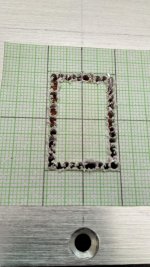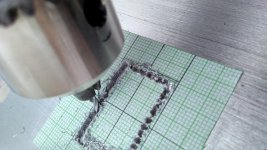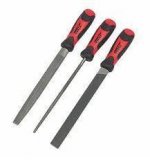Of course you can buy a chassis punch and have a perfect hole for power connectors every time.
| 28 x 21mm Hand Rectangular Punch & Die Combinations |
| 28 x 21mm Hand Rectangular Punch & Die Combinations |
Of course you can buy a chassis punch and have a perfect hole for power connectors every time.
| 28 x 21mm Hand Rectangular Punch & Die Combinations |
Does that seem cost-effective for a guy who builds the occasional tube amplifier?
I mean, I would love to do some of my own work on my car, but I'm not going to buy a hydraulic lift for my garage. I know people who do; but it seems for them, the work they want to do is their excuse to purchase expensive tools for themselves. You're talking to a guy who doesn't own a Dremel. I have a hand drill and some files, and yes, I did buy some cheap chassis punches at Harbor Freight for $12 once.
I think those kinds of tools are very cool. Also wildly inappropriate for the one-off home build. They look like fun, though.
I know what you're saying, but you don't appreciate the level of my inability to cut a straight line of any kind! 😉
I have indeed cut out rectangles for the IEC that I tried to 'hide' the ragged holes; it was like that time I tried to fool my parents by moving the footstool to cover the place I burned in the carpet when I was a kid (not quite 40 years ago when I actually was a kid). I'm just that bad at it!
I'm the exact same way (and some of it is that I lack the space and tools)
There are some connectors that have a little more of a bezel which gives more room to mess up. My other thought was to use some lexan/acrylic/plexiglass and a laser cutter to do the percise cutout (since my city actually has a laser cutter at the library! but most people know a guy who knows a guy 😉 ) then you can do a really rough hole and cover it with the acrylic.
While I like some of the non IEC connectors others have posted the draw back is you have a special cable and I have a zillion of those standard IEC power cables kicking around.
A dremel is a really inexpensive but hugely valuable tool.
It's very, very hard to mess up a short straight line with one.
It's very, very hard to mess up a short straight line with one.
I use calipers to score lines on the inside of the panel and then drill the center out with a step bit. Clean the rest up with a dremel/file and call it a day. I've never messed up to where the flange of the socket wouldn't cover it.
Do you need a detachable power cord? Why not use a snap-in grommet/strain relief clamp? Then you just drill a hole of the appropriate size...
Are there compact strain reliefs that fit in a circular hole? All the cords and black (squish and insert) strain reliefs I 'salvage' come from equipment having a hole with 'flats' for the strain relief.
A dremel is a really inexpensive but hugely valuable tool.
It's very, very hard to mess up a short straight line with one.
What tool are you using in the Dremel? Abrasive disk?
I've used some of those, and aside from their delicacy (I always wear a full face shield), they didn't cut aluminum very well (the old 'never try to work aluminum on the shop grinder' thing??).
Also, I can't cut into a corner with a disk- same reason I can't cut a square hole with a Skilsaw.
There must be something better that I've overlooked.
Yes, I have also considered that.
There are some nice locking cord restraints that mount in a round hole, and they are much better than the
Heyco type strain reliefs that need a D hole. You can get them for a wide range of cord diameters, too.
Last edited:
Are there compact strain reliefs that fit in a circular hole? All the cords and black (squish and insert) strain reliefs I 'salvage' come from equipment having a hole with 'flats' for the strain relief.
The ones I've seen have flats on the sides, however they will fit into a circular hole as well. The flats prevent the strain relief (and power cord) from rotating and thus twisting the wires inside the chassis; probably not that necessary for an item that remains mostly stationary. However, to protect against rotating, you can also clamp the power cord to the inside of the chassis near the entry hole.
Just want to share what i have accomplished with hand tap, hand drill, and flat iron miser (this last item hopefully correct in english as google translate). My amplifier back panel only has iec hole, but i have to make extra hole for on/off socket, while for fuse,rca, and binding post is easy. So below step for rectangular hole on 3mm alum.
1. Mark your alum with a stright line with pencil as your reference.
2. Glue milimeter paper on plate alum and draw your rectangular
3. Use hand tap and mark 3mm inner rectangular line with 2mm distance
4. hand drill 2mm size, after all holes drilled then use 2.5mm size and this is the trick : while drilling, pull and push along the holes just like you are cutting with drill.
5. Clean the miser
Then you have rectangular holes, yes not perfect but from outside you'll not see imperfertion since it's covered by socket boundary
1. Mark your alum with a stright line with pencil as your reference.
2. Glue milimeter paper on plate alum and draw your rectangular
3. Use hand tap and mark 3mm inner rectangular line with 2mm distance
4. hand drill 2mm size, after all holes drilled then use 2.5mm size and this is the trick : while drilling, pull and push along the holes just like you are cutting with drill.
5. Clean the miser
Then you have rectangular holes, yes not perfect but from outside you'll not see imperfertion since it's covered by socket boundary
Attachments
Last edited:
this is what use for cutting rectangular holes, just one 10mm hole and you can nibble away...:
An externally hosted image should be here but it was not working when we last tested it.
An externally hosted image should be here but it was not working when we last tested it.
this cits straight line quite well if you take you timeOr pay up and go MIL-spec PT02E-12-3P Amphenol Industrial Operations | Connectors, Interconnects | DigiKey
You can find second hand amphenol connectors fairly cheap on ebay, usually from old military equipment. Very rugged connectors with silver plated connects, only downside is they are usually a dull green colour which some might find a bit ugly.
The only reason to have a connector is to try different power cords. The IEC 320 socket is the standard. If you are not into swapping power cords, direct connection of the cord inside the chassis is the best option.
As a side note I was crushed by the poor construction (and that's an understatement) of the punch and die set shown in the RS page.
The die (female) part is made out of 2 parts 😱 barely joined by 2 thin screws (around 4 mm) 😱

WTF?
I own lots of die sets for punching my own chassis, cutting and stamping my own strip handles, corner protectors, etc. and *all* are one piece, very strong heat treated tool steel, you can use nothing less there.
What is RS trying to pull?
And they are not charging $15 for the set, but what a well made one would cost.
The die (female) part is made out of 2 parts 😱 barely joined by 2 thin screws (around 4 mm) 😱

WTF?
I own lots of die sets for punching my own chassis, cutting and stamping my own strip handles, corner protectors, etc. and *all* are one piece, very strong heat treated tool steel, you can use nothing less there.
What is RS trying to pull?
And they are not charging $15 for the set, but what a well made one would cost.
As a side note I was crushed by the poor construction (and that's an understatement) of the punch and die set shown in the RS page.
The die (female) part is made out of 2 parts 😱 barely joined by 2 thin screws (around 4 mm) 😱

WTF?
I own lots of die sets for punching my own chassis, cutting and stamping my own strip handles, corner protectors, etc. and *all* are one piece, very strong heat treated tool steel, you can use nothing less there.
What is RS trying to pull?
And they are not charging $15 for the set, but what a well made one would cost.
I somewhat agree with you but keep in mind there is no stress applied where the parts are screwed together.
As a side note I was crushed by the poor construction (and that's an understatement) of the punch and die set shown in the RS page.
The die (female) part is made out of 2 parts 😱 barely joined by 2 thin screws (around 4 mm) 😱

WTF?
I own lots of die sets for punching my own chassis, cutting and stamping my own strip handles, corner protectors, etc. and *all* are one piece, very strong heat treated tool steel, you can use nothing less there.
What is RS trying to pull?
And they are not charging $15 for the set, but what a well made one would cost.
i want this, will add to my list of tools to buy....😎
i will find out if these are good, $15 is not such a bad price...cheap if i may say so...
thank you for the link....😉
- Status
- Not open for further replies.
- Home
- Design & Build
- Construction Tips
- Alternatives to IEC Power Jacks



